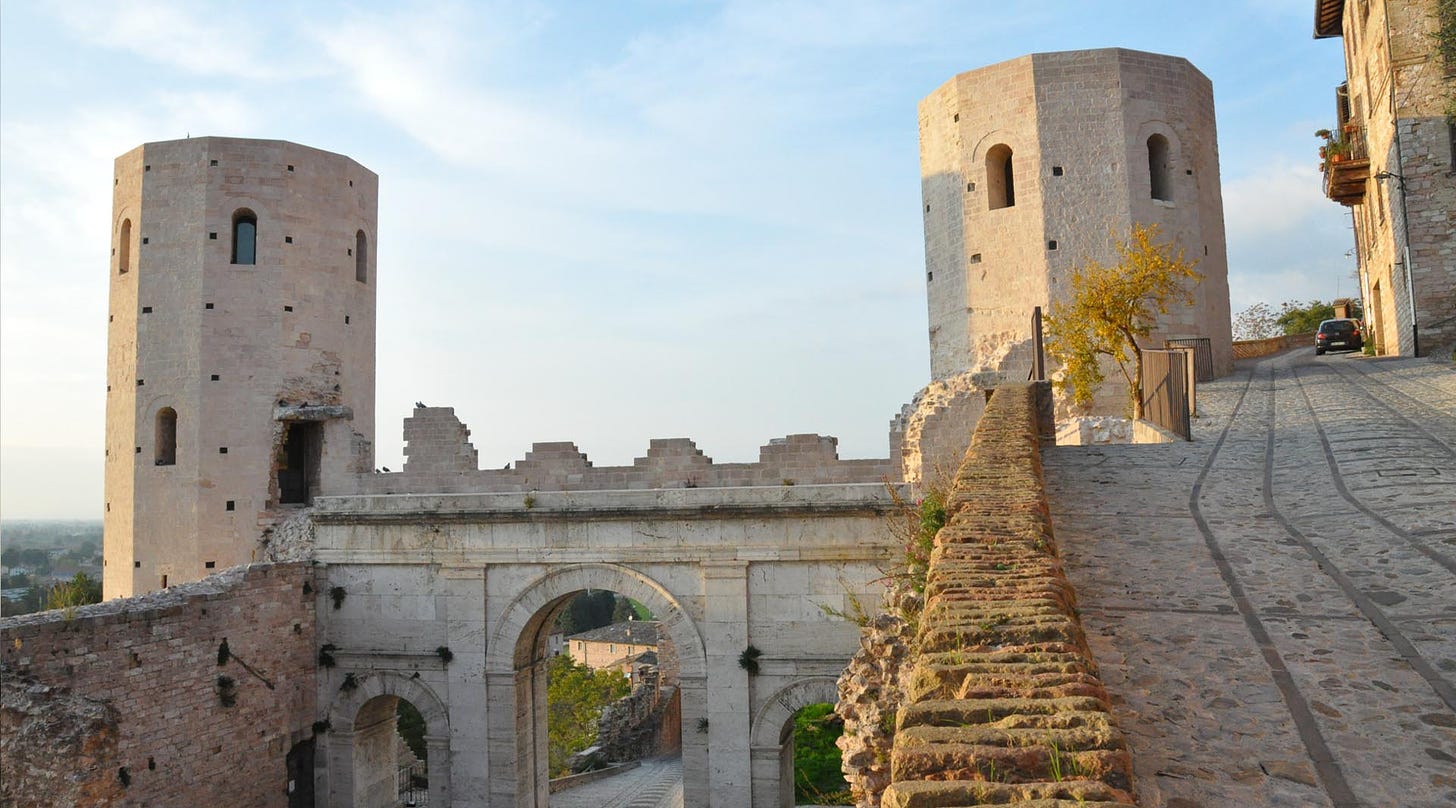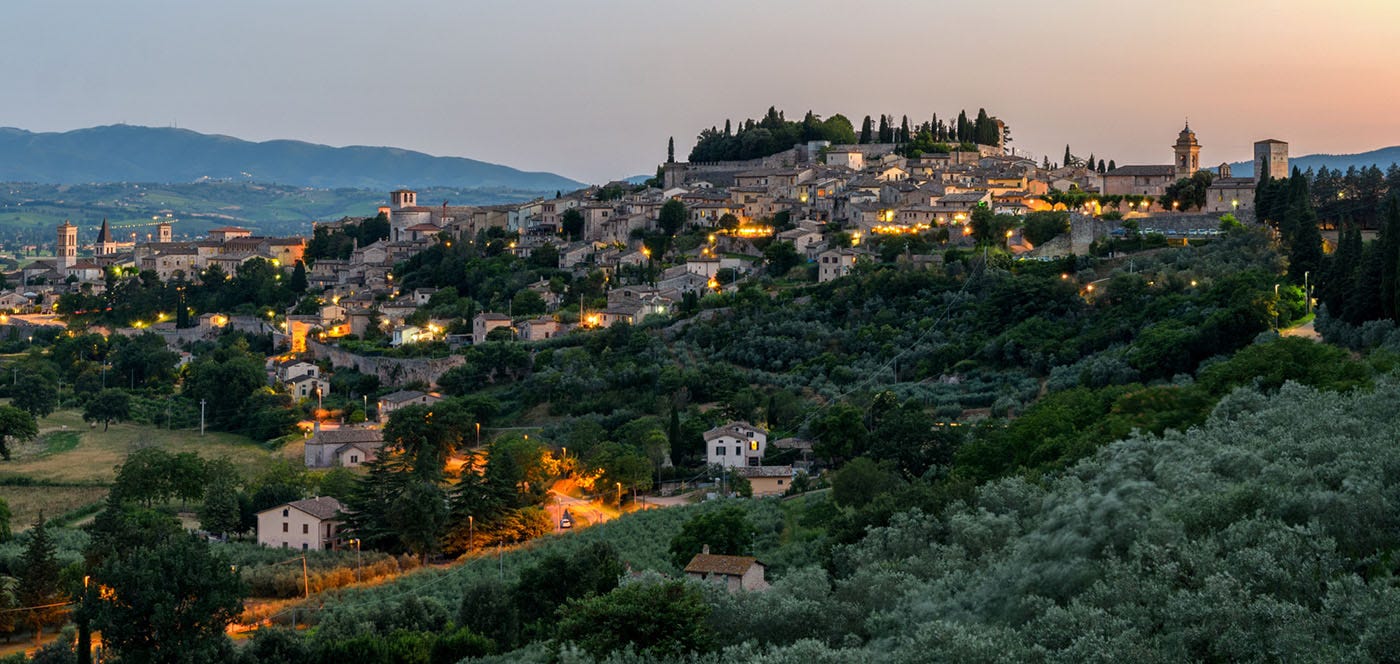The ancient town center of Umbrian origin, “Hispellum” from the first century BC, was an important Roman town given the title ” Splendidissima Colonia Julia.” {1}

{Spello photo Attribution via Umbria Tourism}
Buongiorno amici:
Today, I am visiting the province of Perugia, with a stop in the splendid Umbrian town of Spello, perhaps one of the most attractive villages in central Italy. Here, you’ll immerse yourself in a truly exceptional naturalistic context—nestled on the southern slope of Mount Subasio and equidistant between Foligno and Assisi. With over 8,000 inhabitants, with its rolling hills covered with olive trees and luxuriant vegetation, Spello represents a shining example of the ancient and articulated Umbrian history that began many centuries before Christ.
For lovers of art, culture, and the typical quiet of central Italy, Spello is the ideal destination to spend a couple of days on vacation. The territory of Spello embraced within Roman remains civil buildings and churches, testify to the numerous historical and political events of which Umbria has been a protagonist over the centuries. The lower part of the city is still surrounded and protected for almost two kilometers by the ancient system of perfectly preserved Roman walls with countless accesses (the “gates” of the city), like Porta Consolare, Porta Urbica, and Porta Venus.
The latter is one of the town’s symbols because of the beautiful and imposing towers of Properzio, placed to protect one of the main entrances of the village located about five hundred meters from the Town Hall. The perfectly preserved 13th-century work centuries it has undergone significant extensions. Currently, it houses the historical archive, the library, the notary archive, and the seat of the prestigious Academy of Constantinian studies. From the Town Hall, I advise you to stroll through the characteristic alleys for a few minutes until you reach the Collegiate Church of Santa Maria Maggiore, one of the most important monuments of Spello.
Built around the year 1000 on a pagan temple dedicated to Juno, it was completed in the 13th century and dedicated to the Madonna. The splendid Baglioni Chapel, frescoed by Pinturicchio, one of the foremost exponents of the Umbrian pictorial school of the second half of the fifteenth century. Del Pinturicchio has also preserved the famous Madonna enthroned and saints in the nearby church of Sant’Andrea, owned initially by the Camaldolese monks and later donated to the Franciscans in the fourteenth century by the bishop of Spoleto. During your walk, we suggest you also visit the church of Sant’Anna and that of San Silvestro, all well preserved and built between the 11th and 14th centuries.
Staying in the vicinity of the church of Santa Maria Maggiore, you cannot miss the attractive Civic Art Gallery of Spello, set up in the beautiful Palazzo dei Canonici (16th century) and which contains works of art created between the 13th and 18th centuries. Within stand out a beautiful fourteenth-century wooden sculpture depicting the Madonna enthroned with the Child, a remarkable Madonna with Child and Saints by Marcantonio Grecchi, and ancient crosses collected from the numerous local churches.
Moving a little away from the central area of Spello, I suggest you visit Villa Fidelia, a building built by the Urbani family in the seventeenth century. The Villa is famous for its lush park and the splendid 18th-century palace, currently home to a permanent exhibition dedicated to the pictorial arts. It is also a set constructed on an ancient Roman sanctuary ruin, and it hosts numerous annual cultural and musical events.
To conclude my short journey dedicated to the discovery of Spello, I would like to point out an event that has always characterized the village every year, in the period between May and June. Called the Infiorata del Corpus Domini, the historical religious event occurs in the center of the town. During the celebration, paintings of sacred inspiration adorn the area made of flowers of every color and size. The event has given Spello the title of “Capital of flowers.” Every alley and balcony participate in the annual competition for the best floral decorations, capable of enhancing even the most hidden corners of this splendid medieval village in Umbria.
{Spello. Photo Attribution via Tour Guide Assisi}
Food in Spello is particularly wholesome and diverse from the nearby regions, even if some preparations seem identical.
When in Spello, try some of these dishes that I have tried and enjoyed immensely.
1)Torta al Testo. A crunchy and unleavened bread cooked over coal on a flat iron gadget called appropriately “Testo” is an alternative to rustic bread, popular among local farmers in the fields. In many ways, the testo resembles the flatbread cooked by the Roman soldiers during the Empire. The filling can include grilled vegetables, cooked or raw hams, charcuterie, aged cheeses, braised mushrooms, caciotta cheese, and local greens. The sky is the limit because of its versatility.
2) Pasta alla Norcina certainly deserves an honorable mention among the first Umbrian dishes. However, there is an age-old dispute about its preparation. Two recipes exist that take the name of Pasta alla Norcina. The first suggests the original Norcina pasta be seasoned only with cream and local sausage, usually combined with strangozzi pasta and farfalle. On the other hand, some claim that pasta alla Norcina should include black Norcia truffles, anchovies, oil, and garlic. Someone even adds chili for a spicer taste. You will be happy with either version, even if you don’t fancy anchovies.
3) Ciaramicola is the Umbrian Easter cake par excellence. It is a donut-shaped cake with a singular pink color, with white icing and colored sprinkles. The different colors of the cake make it almost a work of art! They refer to the colors of the districts and the coat of arms of Perugia. Prepared in ancient times only in the Easter period, but practically available in every pastry shop and bakeries throughout the region and every season. Flour, sugar, lard, eggs, alchermes, butter, milk, colored sprinkles, and grated orange peel as the icing on the cake. Nothing more to add; it is truly remarkable. {Read more on Ciaramicola here}.
4) Impastoiata is another traditional Umbrian tasteful recipe, a perfect dish to savor during the winter. Based on legumes and polenta, nutritious in its essence, a specialty of humble origins and popular among the farmers who consumed it to recover from the many daily efforts. It was tradition to eat meat only on Sunday; therefore, the Impastoiata filled the hard-winter nights, served warm as a first course, or leftover for the day after.
5) Panzanella is a single dish typical of the peasant tradition of the region and Tuscany. Prepared with stale bread and seasonal vegetables such as tomatoes, onions, cucumbers, and greens, Panzanella thrives during the summer months when the harvest offers the most delicate flavors. Still, it is an excellent option for the winter times, using the vegetables of the season. Its notoriety spilled into Umbria, and Spello’s restaurants offer a perfect rendition.
6) Truffle omelet does not need any introduction. You can make it by beating the eggs as you would for an ordinary omelet. You can add cured meats and cheeses in the mix or simply an excellent selection of fresh vegetables. Once the omelet is ready and fluffy, shave some great truffle flakes on the surface and serve with rustic Umbrian bread, soaked in extra virgin DOP Colli Assisi-Spoleto or Trevi.
7) Strangozzi pasta represents Umbria like no other form of pasta. Locally known as “Stronzozzi,” the long and rectangular pasta includes good Umbrian soft wheat and water and always without eggs. The thick and rough surface of Strangozzi pairs well with all types of rich sauces, and especially crumbled sausages.
Thanks for reading. Eat safe! Ciao Chef W
Download Chef Walters E-Books
Please tune in to our latest Flavors + Knowledge Podcast
Subscribe to the Italian version SAPERE + SAPORI
Subscribe to News you can eat 24 Video-Cast on YouTube
Support Chef Walters Children’s Diabetes Foundation
For recipes, visit the chef blog.
Note: The views and opinions expressed in the Flavors and Knowledge newsletters are those of the authors and do not necessarily reflect Flavors and Knowledge’s official policy or position. Our blogger’s or authors’ content is of their opinion and not intended to malign any religion, ethnic group, club, organization, company, individual, or anyone. Any general advice posted on our blog, website, or app is only for informational purposes and, without any intentions, to replace any medical or other advice.
| 3 |






